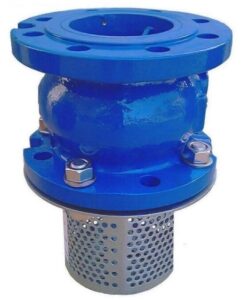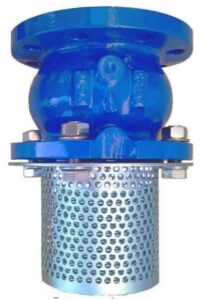Configuration options
 |
GG25 Axial Check Valve with Flanges w/ Stainless Steel Strainer |
 |
GG25 Axial Check Valve with Flanges w/ Galvanized Steel Strainer |
Possibility of changing Carbon Steel Sieve.
– Flanges dimensions according to UNE-EN 1092-2 PN16.
– Holes dimensions according to UNE-EN 1092-2 PN10 / PN16.
CHARACTERISTICS:
– Axial check valve for protection and non-return for clean water.
– The valve will be installed in horizontal or vertical pipelines.
– Silent operation.
– Easy maintenance.
– NBR temperature: From -10 to +80 ºC.
– Leakage rate according to EN 12266 (ISO 5208).
| Temperatura máxima | 80 ºC |
|---|
Aplications
Foot valves are commonly used in ponds, swimming pools, wells and almost anywhere there is a pump.
The surface or opening of the foot valve is larger than that of the pipe, thereby minimizing pressure loss (energy dissipated due to friction along the pipe).
Or also called silent spring check valve.
Our axial check valve is spring loaded and is a type of valve used to prevent reverse flow of fluids in different industrial applications and also to eliminate water hammer and its associated problems.
This valve works based on the pressure difference, that is, it opens when the suction pressure is high and closes when the suction pressure is lower than the outlet pressure.
Water hammer causes mechanical stresses in the piping system that can interfere with the structural integrity of pipes and plumbing fixtures. That is why our valve is designed so that it can close slowly so that water hammer, vibrations are eliminated and reverse flow of fluid is also prevented. The spring in this valve serves to slowly return the disc to its seating position after the fluid pressure begins to reduce. This valve is intended to ensure that the fluid flows in only one direction and cannot flow backwards.
This valve can also act as a suction valve (foot valve) to be placed at the bottom of a pipe line or in a pump, if we attach a steel strainer to one of its flanges.
